HAINA NO NFOOT
HAINA NO NFOOT
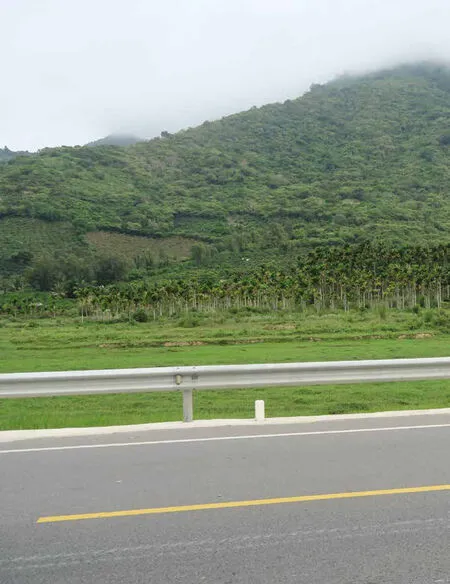
TEXT BY DAVlD DAWSON PHOTOGRAPHS BY LlNDSAY AND ABRAM SOPENSkl
Starting a walk across China in the lush hills of Hainan
美国脚步丈量中国南北:第一站,海南!
Lindsay and Abram Sopenski have a goal which sounds deceptively simple: they're walking across China.
The frst step for the American couple aside from learning the basics of the language (which Lindsay had done by moving to Kunming in 2012 and from a number of other trips) was to decide on a route. They picked a south-to-north route, beginning in Hainan—each time starting at the point where the last trip fnished. They are aiming to fnish the trip in Mohe, Heilongjiang.
The frst leg of the journey lasted for 18 days in May and June and stretched across 200 miles of Hainan.
“We knew we wanted to walk across China, and after that it wasbasically a process of elimination,”Lindsay told TWOC. “We took into account things like climate, weather,elevation, civil unrest, and populated areas. Walking west-to-east or east-towest would be through a lot of lesspopulated areas and would require more gear and knowledge of offcial policy, so that left us with deciding whether to walk starting from the north or south.”
There were certain rules which were to be followed as best they could. Using cars, they decided, would be fne, but afterwards, they had to go back to where they got in the car to keep walking. The whole land distance is to be covered on foot.
“Most days we walked there, the majority. There were fve occasions we didn't make it. Twice we took taxis, twice we got motor-bike-bench things,like tuktuks, and once we hitchhiked on the back of a motorbike with a truck bed,” Lindsay says.
For their frst leg, Hainan, the pair essentially plotted a route with population centers every 15 miles. They did not have bookings, so at each location they needed to meet with locals (or use booking apps) to determine where to stay.
The pair also found that while Google Maps may be the most accurate English map app, the fact it is blocked in China can cause headaches.“It was challenging to decipher from the English maps available which roads had better access to more food and stay. Most foreign apps with the‘nearby feature' are inaccurate. We switched roads once on the walk but had a much harder time fnding food and ended up taking a taxi to the nearest city each night.”
They began in the luxurious environment of a Hyatt Resort in Sanya (三亚) and the frst full day of walking began on the second day. “We struggled to fnd the actual southernmost point, there are many restricted area and they were heavily guarded. We didn't plan for that. We ended up just going as far south as we could, to Yalong Bay (亚龙湾).”
During those 11 miles, they were told by a local that they should just fy right to Heilongjiang instead of walking so they could avoid the sun which would“make you ugly”. The caution about the sun was well-founded. When asked what she would have liked to avoid,
Lindsay said “the heat”.
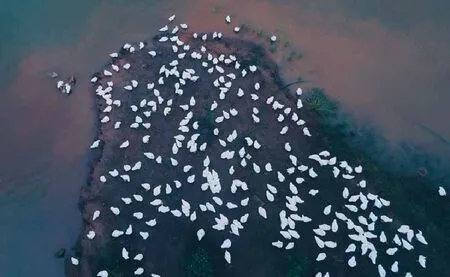
Ducks feed at a duck farm in Jiuzhou, Hainan, on May 31, 2016
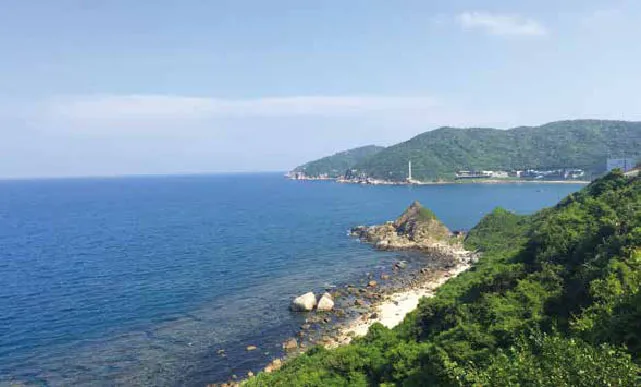
Abram and Lindsay began their walk across Hainan from Yalong Bay
“WE PLANNED TO TENT MOST OF THE TlME, BUT BEcAUSE OF THE OVERWHELMlNG HEAT WE cOULD NOT”
“Even if it says it's 98 degrees (36.6 degrees Celsius), you should really be following the heat index or what it ‘feels like',” she said. “Most days it was a heat index of 115 to 118. I wish we could have mentally prepared for that one.”
On the third day of the trip they took a midday nap in the shade outside a store in order to avoid the heat. “We planned to tent most of the time, but because of the overwhelming heat we could not,”Lindsay said.
They would also discover that the dialects were vastly different in each area of Hainan. Abram did not have much by way of Mandarin skills,and Lindsay had to adapt what she had learned. “It's complicated here because each city and province, and village practically, has their own language and with that comes a heavy accent when they speak Mandarin,”she wrote on their website log.
Another diffcult thing to adjust to was the difference in car-horn culture;Lindsay found the constant beeps far more unnerving than the curiosity of locals. Conversely, the local quirk of some parts of Hainan for coffee over tea, a marked contrast to the rest of China, was a pleasant discovery.
In one instance a lady surprised them by offering a delicious cup of coffee as an energy boost. “Hainan is one of the few places where the local drink coffee—and I'm not talking about the Starbucks outlets in the big cities,” Lindsay told TWOC. Indeed, Hainan has a long history of coffee drinking, though travelers need to stumble across the proper nooks and crannies dedicated to the beverage. Fushan (福山) and Xinglong(兴隆) counties in particular grow
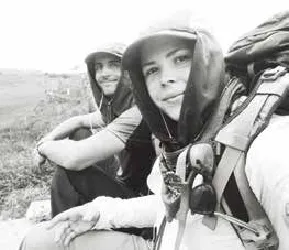
Lindsay and Abram Sopenski are planning to walk across China from south to north. Lindsay has been planning the trip ever since 2012. “I think they are just now starting to let it sink in that I really mean it,” Lindsay says of the reactions of her friends and family after walking across Hainan Province in May and June. “We still have to tell people, about six times,that we are walking the entire way using only our own two feet,” she adds.“Most Chinese don't believe it the first three times and keep asking, ‘What transport are you taking?'” Abram Sopenski was new to China for the Hainan trip, though Lindsay had visited China and lived on-and-off for years, in addition to studying Mandarin for two years which gave her a basic grasp of the language.
Follow their trip at WalkAcrossChina.comcopious quantities of coffee, though they aren't the most tourist-friendly locations, so fy-in-fy-out tourists often miss this aspect of the province. Fortunately for the Sopenskis, the walk allowed them to discover hidden joys, but also take rests, like a day break in Lingshui Li Autonomous County (陵水黎族自治县), which was one of their favorite areas of the trip.
The Li are Hainan's largest ethnic minority group, with fve separate branches: Ha, Qi, Run, Sai, and Meifu. With centuries of cross cultural pollination between Hainan,Guangxi, and Vietnam, the Li have forged their own distinctive culture and even their own language which is distinct from Putonghua or Hainanese dialects—though fortunately, most don't speak it exclusively.
One key advantage in doing the trip this way was the opportunity to have unexpected encounters. On the sixth day, they took refuge “in the middle of nowhere during a downpour” and had a pleasant surprise.
“We realized it was a hub for cyclists biking around the island,”Lindsay said, adding that it was a joy to discover the local community of cyclists and artists.
The couple had stumbled upon one of heartland Hainan's biggest draws for tourists seeking something different from the beaches of Sanya: biking culture. With the Tour of Hainan race as a calling card, cyclists have been focking to Hainan in recent years to take advantage of the tropical vistas. Remote areas of the province have become home to bicycle vendors who service travelers taking advantage of coastal routes with reliable road networks.
There were some encounters that were less than pleasant; the Sopenskis advise other travelers to be wary around some of the locals who have had a bit too much to drink and who can often be spotted eating a lot of the local red betel nut stimulant.“They can be a bit aggressive and overwhelming in the small towns,”Lindsay added. She did also point out, however, that travelers should“not be afraid to jump in with the locals and enjoy the local food,”she said. “Don't let the cultural differences intimidate you.”
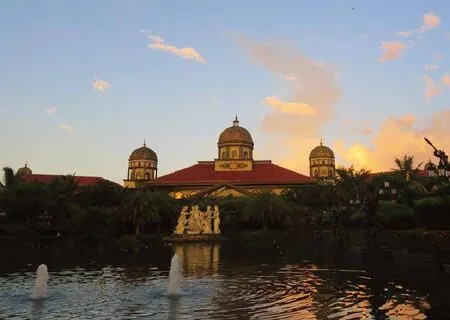
On the 15th day of their trip they came across a housing development made to look like Venice near Liuzhou
On some of their most diffcult days, they took solace in the kindness of strangers. On the 14th day, aftera lightning storm had delayed the already exhausted couple, a stranger helped them fnd a place to eat and came back to give them fruit. “We have been so overwhelmed by the kindness of people, especially these last two days,” Lindsay wrote. “The man who gave us a ride was so sweet, and we've had waves and smiles all along our route.”
The most bizarre experience was a nearly-abandoned village they came across that had been constructed almost entirely in Italian style. “This place recreated the statues, fountains,landscapes, and domes of Venice. They rented us a room for the night and it was completely silent because most of the place was completely empty,” Lindsay wrote.
She suggests avoiding some of the
more tourist-focused areas, such as Sanya and Haikou. Abram also suggests that if travelers are walking for long periods in the sun, a cold beer at the end of each day is a must,but that it isn't necessary to carry a lot of water as almost every corner store sells it.
The next leg of their trip will commence in October, south of Guangzhou. They plan to get as far north as they can in the period until Christmas, as around that time the temperatures will start getting cold and they plan to take a break.

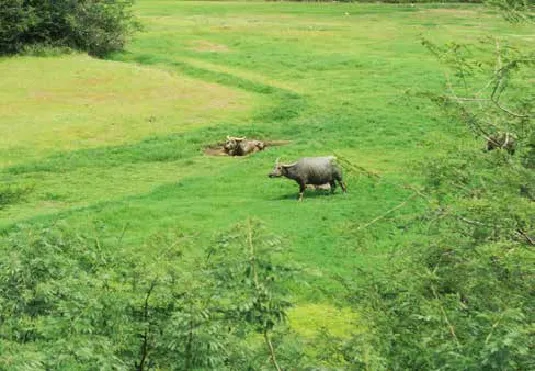
Water buffalo stand in a small pond to stay cool in the heat near Wanning on May 24, 2016

Yellow Plumeria flowers near Yalong Bay on May 19, 2016
——电影《郭福山》主题歌(男中音独唱)

